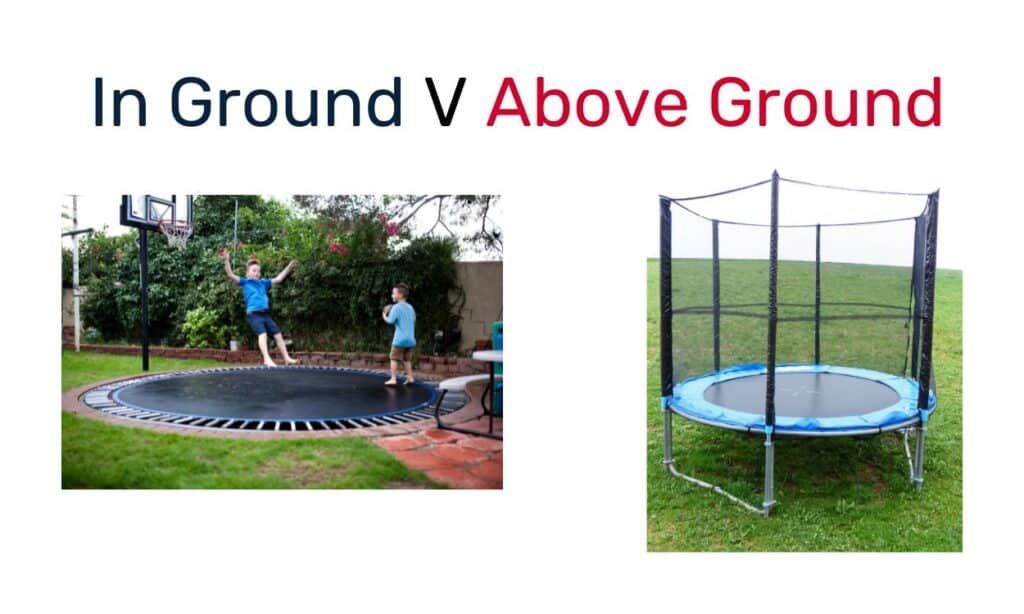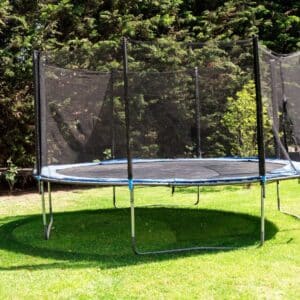
Above-ground trampolines can raise safety and aesthetic concerns. In-ground trampolines offer a modern alternative that may resolve these issues, but is it worth the extra effort and cost to bury a trampoline several feet into the ground?
In this blog post, we’ll explore the benefits and potential drawbacks of in-ground trampolines. We’ll delve into their safety features, installation process, maintenance requirements, and overall impact on your backyard’s appearance.
What is an in-ground trampoline?
An in-ground trampoline is installed in a hole so the frame sits level with the ground. This design makes it easier to use, reduces tipping risks, and offers a more attractive appearance compared to above-ground trampolines.
In-ground trampolines can be considered safer compared to traditional above-ground trampolines for many reasons, but safety ultimately depends on various factors and how well they are installed and maintained. Whichever way a trampoline is installed, the risk of injury can never be completely eliminated so it’s always useful to weigh up the pros and cons of each if you are considering purchasing a new trampoline for your backyard.
Before we go any further, it’s worth pointing out that in-ground trampolines and above-ground trampolines are usually exactly the same in design, it’s the way they are installed and set up that differentiates them.
Discover our top picks for Trampolines for Gymnastics.

What is an above-ground trampoline?
An above-ground trampoline is placed directly on the surface, such as grass or concrete. While the frame and components are similar to in-ground trampolines, the installation differs, as above-ground trampolines sit visibly above the ground.
Above ground trampolines are easier to install than in-ground trampolines because there’s no need to dig a big hole and they can be moved around the yard if necessary. However, they are less aesthetically pleasing than in-ground trampolines and have a higher risk of tipping over.

Are In-Ground Trampolines Safer?
In-ground trampolines are safer because they sit level with the ground, reducing the height of potential falls. However, all trampolines carry some risk of injury.
It doesn’t completely eliminate the chance of a fall – trampolines by their very nature will always cause falls and drops, it just means that when it does happen the height of the fall is reduced.
In-ground trampolines don’t usually have safety enclosures (nets) because of the lower height. This makes them more aesthetically pleasing to look at and makes backyards seem more spacious.
Above ground trampolines are generally less safe than in-ground trampolines. They sit higher off the ground, increasing the risk injury caused by falling to the ground. For this reason, safety enclosures are recommended and despite them being a big help, they can often fail due to damage and wear and tear.
Above ground trampolines can also tip over if not properly secured, which can be dangerous. To minimize the risk of injury, it’s essential to follow the manufacturer’s guidelines for installation and use. Also, follow the guide to winterize a trampoline and avoid high winds tipping your trampoline over in the bad weather.
In-Ground v Above-Ground Comparisons
Choosing a Trampoline is never easy. In addition to safety factors, there are a number of other comparisons which are worth considering to help you make the right choice for your family.
1. Cost Comparison
In-ground trampolines generally cost more than above-ground models due to the need for excavation, retaining walls, and drainage systems. Above-ground trampolines require less setup and are quicker to install.
As mentioned already, the actual trampoline which sits in the ground can usually be the same as a typical above-ground trampoline. So the increased cost is purely from the installation.
2. Installation
Installing an in-ground trampoline involves digging a hole, leveling the site, adding retaining walls, and setting up drainage. This process can take days and may require professional help.
Above-ground trampolines, on the other hand, can usually be installed in a matter of hours with a few basic tools.
3. Maintenance
Both trampoline types need regular maintenance to stay safe. In-ground trampolines face less weather exposure but still require cleaning, and their springs and pads may need periodic replacement.

The hole under the trampoline will need to be cleaned every so often as leaves, branches and other items can often fall down gaps and build up at the bottom. If there is drainage this can potentially get blocked unless it is properly maintained.
Above ground trampolines should always be used with a safety net or enclosure which needs to be maintained and cleaned to prevent damage. However, even with the right maintenance this is one of the parts that will need to be replaced through wear and tear. In ground trampolines can be used with a safety net but many people don’t use them because of the level height with the ground. This reduces the time and money needed to maintain an in ground trampoline.
4. Durability
When it comes to durability, in-ground trampolines are generally more durable than above ground trampolines. In-ground trampolines are less exposed to the elements, making them less likely to suffer from rust, wear and tear, and damage from extreme weather conditions. Above ground trampolines, on the other hand, are more susceptible to damage from wind, rain, and sun exposure.

5. Aesthetics
In terms of aesthetics, in-ground trampolines are generally more attractive than above ground trampolines. In-ground trampolines sit flush with the ground, making them blend in better with the surrounding landscape. Above ground trampolines, on the other hand, are more noticeable and can be an eyesore in some backyards.
The more favorable aesthetics of an in-ground trampoline will require more time and effort to be created, especially if safety is a priority. This will often mean landscaping lawns, removing hard surfaces around the trampoline and moving large objects to create a safe space.
6. Space Requirements
When it comes to space requirements, both in-ground and above-ground trampolines require a certain amount of space to install. However, in-ground trampolines require more space as they need a hole dug in the ground. Above ground trampolines can be installed in smaller yards and can be moved around if necessary.
7. Portability
Above-ground trampolines are portable and can be moved as needed. In contrast, in-ground trampolines are fixed installations.
8. Accessibility
In-ground trampolines are easier to access as they sit level with the ground. Above-ground trampolines often need ladders, which can be challenging for children and people with mobility issues.
9. Comfort
In terms of comfort, both in-ground and above-ground trampolines are comfortable to jump on. However, in-ground trampolines are often considered more comfortable as they sit at ground level, reducing the impact on your joints.
10. Performance
When it comes to performance, both in-ground and above-ground trampolines perform equally well as the trampoline itself can be identical. There are no differences in the design or performance of either, its just about where the trampoline is placed. Placing a trampoline in-ground will not reduce its performance or bounce.
How To Install In-Ground Trampoline
Disclaimer: This guide should be used as generic advice. We recommend consulting a construction professional before commencing an in ground trampoline installation.
A normal trampoline can be installed in ground or you can opt for a trampoline specifically designed to go in ground like the one pictured below. The specially designed ones usually provide additional matting around the edge making it safer for the users.

Step 1: Choose the Right Location
- Flat Ground: Select a level area in your backyard. This ensures stability and makes the installation process easier.
- Clear Space: Ensure there are no obstacles like trees, fences, or power lines near the site. A clear area around the trampoline adds to safety.
- Drainage: Choose a location with good drainage to avoid water accumulation under the trampoline.
Step 2: Gather Materials and Tools
- In-Ground Trampoline Kit: Purchase a high-quality in-ground trampoline kit, which should include the trampoline frame, mat, springs, and retaining wall.
- Tools: You’ll need a shovel, spade, wheelbarrow, spirit level, tape measure, utility knife, and possibly a compact excavator for digging.
- Drainage Materials: Gravel or drainage pipes to prevent water buildup.
- Protective Gear: Gloves, safety glasses, and sturdy footwear.
Step 3: Mark and Dig the Hole
- Outline: Using the trampoline frame as a guide, mark the perimeter of the hole. Add an extra foot around the perimeter to allow for the retaining wall.
- Digging: Excavate the hole to the required depth and diameter specified by the manufacturer. Typically, this will be around 1 foot deeper than the height of your trampoline and with a diameter matching your trampoline size.
- Shape: The hole should have sloped sides, with the center being the deepest point to facilitate drainage.
Step 4: Install Drainage System
- Gravel Layer: Spread a layer of gravel at the bottom of the hole to aid in drainage. This helps prevent water from accumulating under the trampoline.
- Drainage Pipe: If your area has poor drainage, consider installing a drainage pipe that leads away from the trampoline site.
Step 5: Assemble the Retaining Wall
- Placement: Position the retaining wall around the inner perimeter of the hole. This wall prevents soil from collapsing into the hole.
- Secure: Follow the manufacturer’s instructions to secure the retaining wall. Ensure it is stable and properly aligned.
Step 6: Assemble and Install the Trampoline
- Frame Assembly: Assemble the trampoline frame according to the manufacturer’s instructions. Ensure all parts are securely connected.
- Positioning: Place the frame into the hole, resting on the retaining wall. Use a spirit level to ensure the frame is even.
- Mat and Springs: Attach the trampoline mat to the frame using the springs. Make sure the mat is taut and evenly stretched.
Step 7: Backfill and Secure
- Backfill: Carefully backfill around the retaining wall with soil. Pack the soil down to eliminate air pockets and provide additional stability.
- Edge Finishing: Create a smooth, level surface around the trampoline edge. You can add turf or other landscaping materials to blend the trampoline with your yard.
Verdict: Is an in-ground Trampoline worth it?
If you can budget for an in-ground trampoline, it offers significant benefits, including improved safety and a more discreet appearance.
However, you should consult the relevant professionals to asses whether your property is suitable for the necessary work before going ahead. Happy bouncing!
FAQs
Can you put a normal trampoline in the ground?
Yes, in-ground trampolines are the same as normal above-ground ones, just they have been put in a hole that’s been dug in the ground!
How deep do you dig for an in-ground trampoline?
The depth will need to be slightly more than the frame of the trampoline. This will ensure that when the frame sits on the concrete base, the top of the frame and the mat are level with the ground.
How much space is required for an in-ground trampoline?
The amount of space required for an in-ground trampoline varies depending on the size of the trampoline. However, as a general rule of thumb, you should have at least 2 feet of clearance around the perimeter of the trampoline.
How often do you need to replace parts on a trampoline?
The frequency of part replacement on a trampoline depends on the quality of the trampoline and how often it is used. Generally, you should replace parts such as the safety net and springs every few years to ensure the trampoline remains safe.
Can you move an in-ground trampoline?
In-ground trampolines are designed to be a permanent fixture and are not easily moved. However, if necessary, an in-ground trampoline can be disassembled and moved to a new location with the help of professionals.
- How To Get Over a Mental Block In Gymnastics: A Complete Guide
 Gymnastics is a sport that requires not only physical strength and skill but also mental strength. When a gymnast feels like they cannot attempt a… Read more: How To Get Over a Mental Block In Gymnastics: A Complete Guide
Gymnastics is a sport that requires not only physical strength and skill but also mental strength. When a gymnast feels like they cannot attempt a… Read more: How To Get Over a Mental Block In Gymnastics: A Complete Guide - Find The Best Leotard For Girls (Guide)
 Finding an ideal leotard for girls isn’t just about picking a dazzling design that sparkles (although it does help!). The leotard has to fit perfectly,… Read more: Find The Best Leotard For Girls (Guide)
Finding an ideal leotard for girls isn’t just about picking a dazzling design that sparkles (although it does help!). The leotard has to fit perfectly,… Read more: Find The Best Leotard For Girls (Guide) - The Best Gymnastics Shorts (Our Top Picks)
 The best gymnastics shorts are designed to be worn over the top of a leotard providing additional coverage around the upper legs, whilst allowing gymnasts… Read more: The Best Gymnastics Shorts (Our Top Picks)
The best gymnastics shorts are designed to be worn over the top of a leotard providing additional coverage around the upper legs, whilst allowing gymnasts… Read more: The Best Gymnastics Shorts (Our Top Picks) - Decathlon Leotards – Are They Any Good?
 If you’re in the market for a new leotard, you may be wondering if Decathlon leotards are any good considering the low cost of their… Read more: Decathlon Leotards – Are They Any Good?
If you’re in the market for a new leotard, you may be wondering if Decathlon leotards are any good considering the low cost of their… Read more: Decathlon Leotards – Are They Any Good? - A Complete Guide to Gymnastics Hand Rips
 Are you tired of dealing with painful gymnastics rips on your hands from training? Look no further – this article offers a comprehensive approach to… Read more: A Complete Guide to Gymnastics Hand Rips
Are you tired of dealing with painful gymnastics rips on your hands from training? Look no further – this article offers a comprehensive approach to… Read more: A Complete Guide to Gymnastics Hand Rips - Is Gymnastics Dangerous? (Facts and Comparisons)
 Gymnastics is acknowledged as a highly technical and physically demanding sport. It inherently carries a risk of injury, which is why most coaches and clubs… Read more: Is Gymnastics Dangerous? (Facts and Comparisons)
Gymnastics is acknowledged as a highly technical and physically demanding sport. It inherently carries a risk of injury, which is why most coaches and clubs… Read more: Is Gymnastics Dangerous? (Facts and Comparisons)
